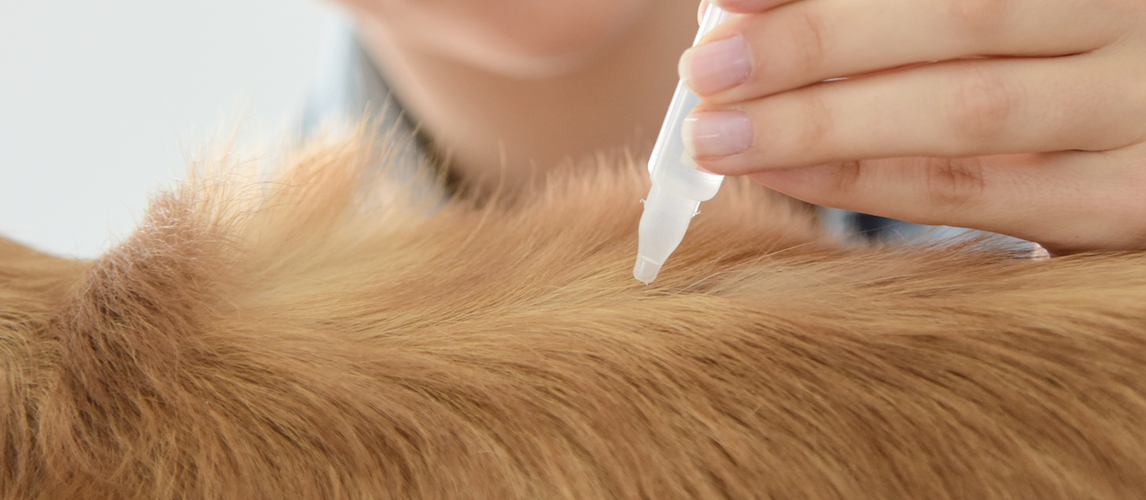Lyme disease is the most common illness transmitted by ticks. It’s a bacterial infection, which makes its way into the bloodstream through bites. Both humans and dogs are vulnerable to Lyme disease, and the illness can trigger a range of unpleasant symptoms including fever and swollen joints. Lyme disease can usually be treated with a course of antibiotics.

Both dogs and their owners are particularly vulnerable to Lyme disease in the summer months, when young ticks are most prevalent. This means that now is the perfect time to make yourself aware of Lyme disease symptoms to watch out for, and find out how you can help to prevent it.
Causes
Lyme disease is caused by the bacterium Borrelia burgdorferi, and is usually carried by the eastern black-legged tick (also known as the “deer tick” or “bear tick”). The bacterium is a spiral shaped microorganism, which is harboured in the tick’s digestive system, and can enter the bloodstream of its host animal through a bite. Ticks themselves are thought to pick up the disease through feeding on mice and other rodents during the larval stage of their lifecycle.
Ticks pose a risk to humans and dogs throughout the US and much of the world, but the following US areas have particularly high rates of Lyme disease:
- The Northeast
- The Upper Midwest
- The Pacific coast
Generally, ticks must be attached to their host for 36 to 48 hours before Lyme disease can be transmitted. Because of this, the disease is actually quite preventable if owners are vigilant. Most cases of Lyme disease are caused by bites from immature ticks, which are called nymphs. This is because their small size – only around 2 millimetres (just under a tenth of an inch) – makes them very difficult to see, meaning they’re more likely to stick around for the 36 hours required for Lyme disease infection. There is currently no evidence that Lyme disease can be transmitted through any means other than tick bites. If your dog does contract the disease, it will not be spread to you through contact with them. Similarly, if you contract Lyme disease, you won’t be at risk of spreading it to other humans or your pets.
If Lyme disease does manage to enter an animal’s bloodstream, it tends to gather around the joints, so swelling in these areas can be a good indication that Lyme disease might be present.
Symptoms
Lyme disease has quite a wide range of unpleasant symptoms in both humans and their canine companions. If your dog exhibits one or more of the following symptoms, Lyme disease could be the culprit:
- Fever
Like many infections, Lyme disease raises the body’s temperature, which makes antibodies more effective at fighting the bacteria. This change can sometimes manifest itself as a fever.
- Loss of appetite
Loss of appetite can be another sign of infection in animals. Sometimes their bodies attempt to purge themselves of the infective agent, and part of the process involves reducing food intake.
- Lethargy and tiredness
When an animal’s body is busy fighting off infection, little energy is left over for activities they usually find enjoyable. Dogs who have contracted Lyme disease are far less likely to enjoy their usual games and walks, and will probably sleep more.
- Stiffness, discomfort, or general pain
Lyme disease can also cause some flu-like symptoms, including achy muscles. If your dog is unusually stiff or appears to be experiencing pain – especially in the summer months – the disease could be at play.
- Swollen joints
As mentioned earlier, Lyme disease bacteria tend to gather around the joints when they enter an animal’s bloodstream. The body’s immune system will try to fight off the invading microorganisms, and the chemicals involved can cause the area to swell and become inflamed. If your dog appears unwell, check to see whether their joints are swollen, as this is one of the biggest indicators that they may have contracted Lyme disease.
- Kidney failure
In extreme cases of Lyme disease, a dog’s kidneys can fail, which sometimes proves fatal. This is due to the strain put on the organs as they attempt to process the toxins associated with the bacterial infection.
- Cardiac issues
It’s very rare, but in some cases Lyme disease can also affect the heart’s function in a variety of ways, including arrhythmia and heart disease. Dogs suffering from heart conditions might exhibit symptoms such as coughing, shortness of breath, and tiredness.
If your dog is suffering from one or more of these symptoms, you should consult a veterinary professional as soon as possible.
To predict the development of Lyme disease, you could check your dog carefully for ticks, or signs of bites. If you do come across a tick, it can be sent by your vet for analysis, to find out whether it’s a member of the Lyme disease spreading black-legged family, and if so whether it is infected with Lyme disease. If the tick is found to harbor the disease, your vet may suggest pre-emptive Lyme disease treatment, such as a course of antibiotics.
Diagnosis
When your dog shows some of these symptoms, or you suspect they have been bitten by a tick, your vet will probably want to test for Lyme disease. Luckily, Lyme disease is fairly easy to identify through the C6 test, which can be carried out either in-clinic, or by sending a blood sample away for laboratory analysis.
The tests work by checking for the presence antibodies which work against the “C6” protein – a protein uniquely present in Borrelia burgdorferi bacteria. Antibodies generally develop in a dog’s body three to five weeks after the initial tick bite, and their presence in the bloodstream suggests that your dog’s immune system has been attempting to fight off Lyme disease.
If the results of the C6 test are positive, your vet will proceed to carry out the Quant C6 test. As its name suggests, this test determines the quantity of C6 antibodies present in the dog’s blood. If the concentration is relatively low, your dog is unlikely to require treatment, but at higher concentrations they could benefit from medical intervention.
If the initial test for C6 antibodies proves positive, your vet will probably need additional blood samples, as well as a urine sample. This will help to determine whether the dog’s kidneys have been damaged by Lyme disease, which would be suggested by the presence protein in their urine. This indicates that the kidneys are not carrying out their proper function of breaking down waste products before they leave the body.
Checking for kidney damage is essential, since this is a potentially fatal issue which Lyme disease can trigger, and should be treated as swiftly as possible.

Treatment
Surprisingly, some dogs can carry Lyme disease without actually showing any symptoms. This means it’s sometimes difficult to know whether treatment would be worthwhile or even necessary. Your vet will be able to advise you based on your dog’s unique symptoms and medical history, but the decision is usually influenced by the following factors.
- The quantity of C6 protein in their bloodstream
If the Quant C6 test reveals that your dog has moderate to high levels of the protein in their bloodstream, your vet is more likely to recommend that treatment is pursued. Conversely, if the concentration is low, they may decide against it.
- Symptoms
If your dog has been displaying one or more of the symptoms closely linked to Lyme disease, such as swollen joints or stiffness, a positive C6 test would support the argument for treating the animal.
- Medical history
If your dog has exhibited similar symptoms within the past year, Lyme disease is more likely to be the culprit, since it can stick around in the body for fairly long periods of time, and periodically flare up in some cases.
- Urine sample results
If the presence of protein in a dog’s urine is found alongside C6 antibodies in their bloodstream, your vet is very likely to recommend treatment. This is because the combination of these indicators suggests that Lyme disease is causing some fairly serious problems in your dog’s body.
Some vets might be reluctant to treat Lyme disease without symptoms for a number of reasons. Firstly, the over-use of antibiotics is a serious issue which has resulted in some harmful bacteria developing a resistance. Additionally, if your dog tests positive the presence of C6 antibodies, especially in low concentrations, it can be difficult to tell whether the bacteria are still present, or if the antibodies are simply left over from a previous infection which went undetected. Finally, since symptoms only develop in around 10% of dogs who contract Lyme disease, treating a symptomless illness could put unnecessary stress on the dog and owner, as well as incurring unnecessary costs.
If your vet does decide to treat your dog for Lyme disease, they will likely suggest:
- Antibiotics, most commonly doxycycline and amoxicillin. Symptoms should begin to improve within 24 to 48 hours, and the course will usually last for around 30 days.
- If necessary, kidney treatment. This could include intravenous fluid therapy, and drugs.
- Depending on symptoms and severity, additional treatment. For instance, if inflammation has been an issue and anti-inflammatory drug might be prescribed.
Once treatment has been completed, your vet might decide to carry out another Quant C6 test, and require another blood sample. If treatment has been successful, you can expect to see a significant reduction in the quantity of C6 antibodies in your dog’s bloodstream. This result, combined with the improvement or alleviation of symptoms are key indicators that the treatment has done its job.
Prevention
As mentioned earlier, Lyme disease is fairly preventable, since as far as we know it can only be transmitted through tick bites. To protect both yourself and your best friend against the illness, you should try to prevent these bites, and endeavour to catch them as early as possible when they do happen. To decrease the likelihood that your dog will be bitten, you can:
-
- Use a spot-on treatment on your dog’s coat. These will repel and kill both ticks and fleas, and each application can remain effective for up to a month.
- Consider an oral anti-tick medication. These pills are usually given once a month, and kill ticks and immature fleas in your dog’s coat.
- Wash your dog with an anti-tick shampoo every now and again, especially in the spring and summer.
- Keep your lawn and any bushes or hedges in your garden or yard well-trimmed, as this reduces the tick populations.
- Consider treating your home for ticks with an anti-flea and tick spray.
- Try applying a tick spray to your dog’s coat between shampoos, to ensure they’re kept at bay.
- Avoid long walks through long grass and brush if possible, since these environments are ideal for ticks hoping to find hosts. They cannot jump or fly, but will crawl to the top of tall plants and try to crawl onto animals as they brush past.
- Thoroghly check your dog for ticks after walks, especially in the spring and summer.
Related Post: Best Dog Shampoo and Tick Repellent for Dogs
Finding and Removing Ticks
Ticks can be tricky to spot on your dog, especially the tiny nymphs. Here are a few tips for finding and removing ticks:
- Brush your fingers through your dog’s hair rather than using a comb; you’ll be able to feel any bumps which could be ticks more easily.
- Make sure you check between the toes, behind the ears, under their limbs, and around the tail and head.
- Be careful when removing ticks, as parts can sometimes break off and remain embedded in the skin.
- To remove a tick, use tweezers, gripping it very close to the skin, before pulling it away gently. Do not burst its body, as this will increase the risk of Lyme disease infection.
- Always wear rubber gloves to protect yourself from Lyme disease when removing a tick from your dog.
- If you are unsure about removing a tick, consult your vet. They will be able to do so safely and effectively, and possibly teach you how to do so for future reference.
- Remove any ticks within 24 hours to minimize the risk of infection.
You May Also Like: Dog Tick Remover Tool
Sources:
- Dr. Jennifer Coates, How to treat Lyme disease in Dogs, Pet MD
- Harriet Meyers, Lyme Disease in Dogs: Symptoms, Tests, Treatment, and Prevention, American Kennel Club
- Dr. Celeste Clements, Lyme disease in Dogs, Pet Health Network







